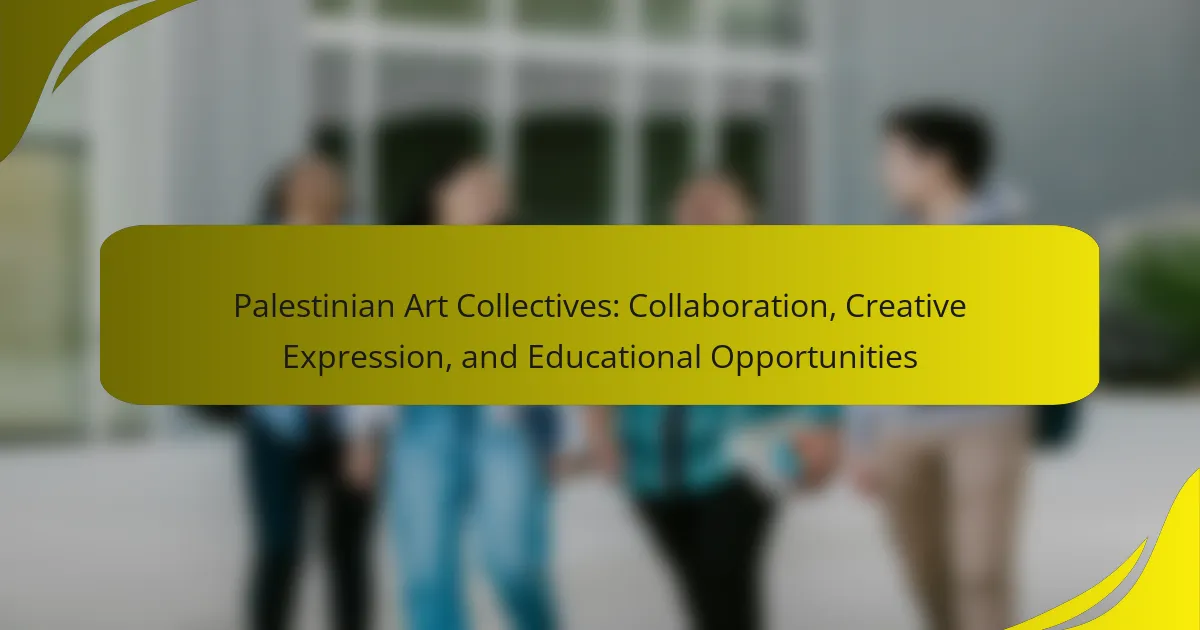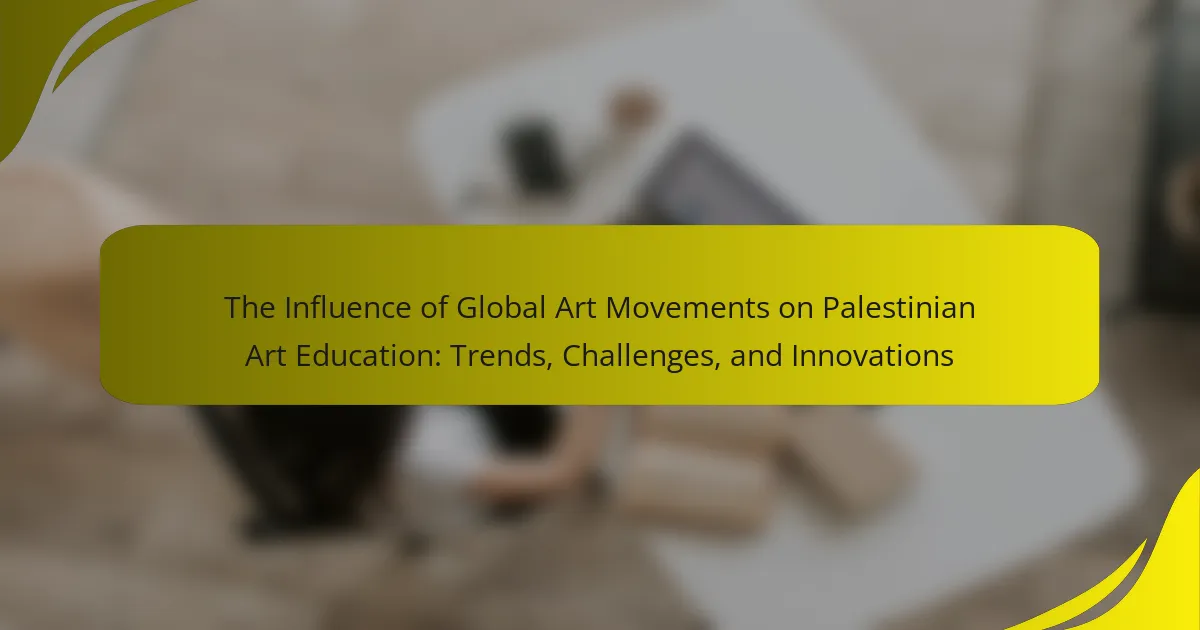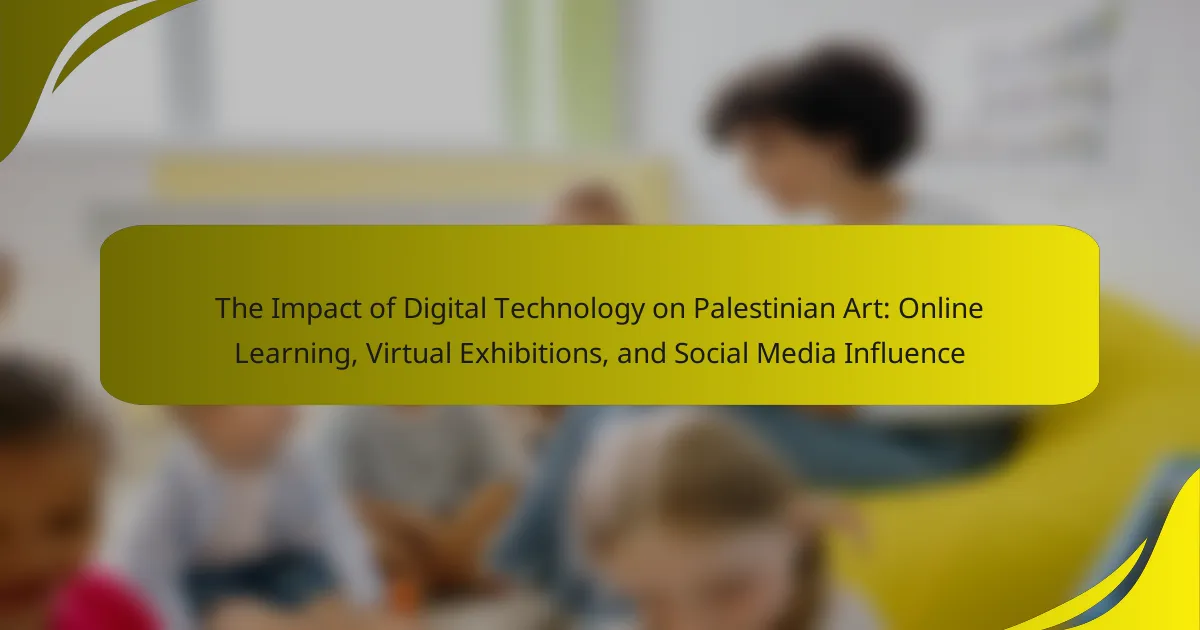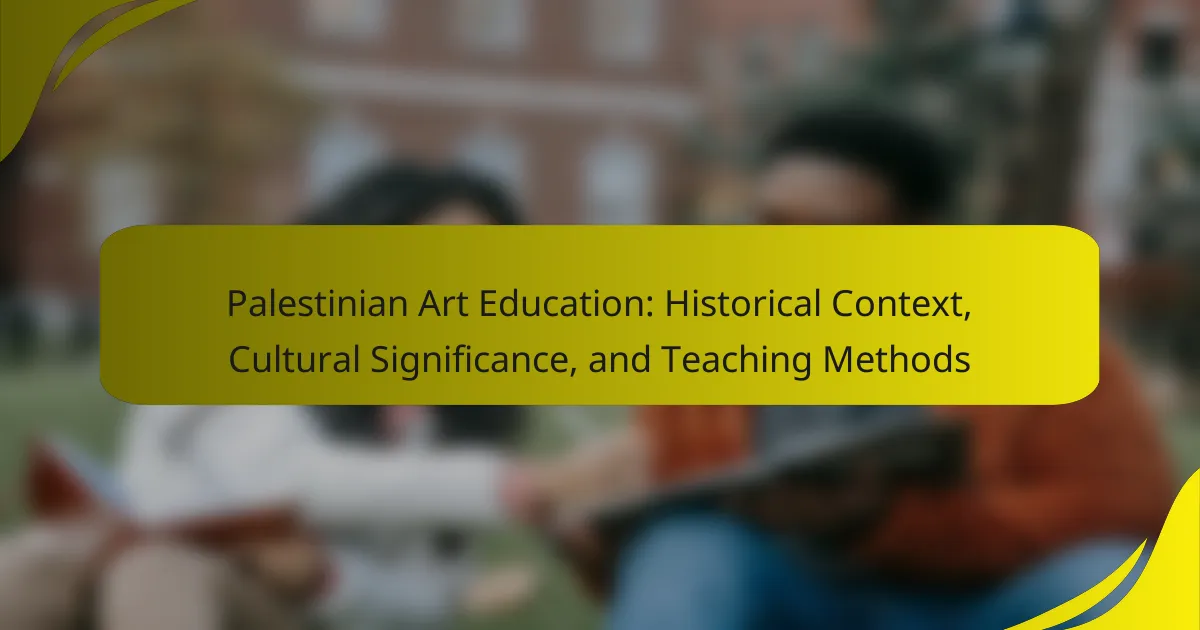Traditional Palestinian art forms encompass techniques such as embroidery, pottery, and calligraphy, which reflect the cultural heritage and identity of the Palestinian people. These art forms, including the intricate patterns of “tatreez” embroidery and unique pottery shapes, have evolved over time under various historical influences, including Ottoman and British colonialism. The 20th century marked a significant shift as Palestinian identity became a focal point in artistic expression, blending traditional motifs with contemporary styles. Today, traditional Palestinian art serves not only to preserve cultural narratives but also to address social and political issues, fostering a connection between past and present while engaging global audiences. This article explores the techniques, materials, and modern adaptations of traditional Palestinian art, highlighting its role in cultural expression and advocacy.
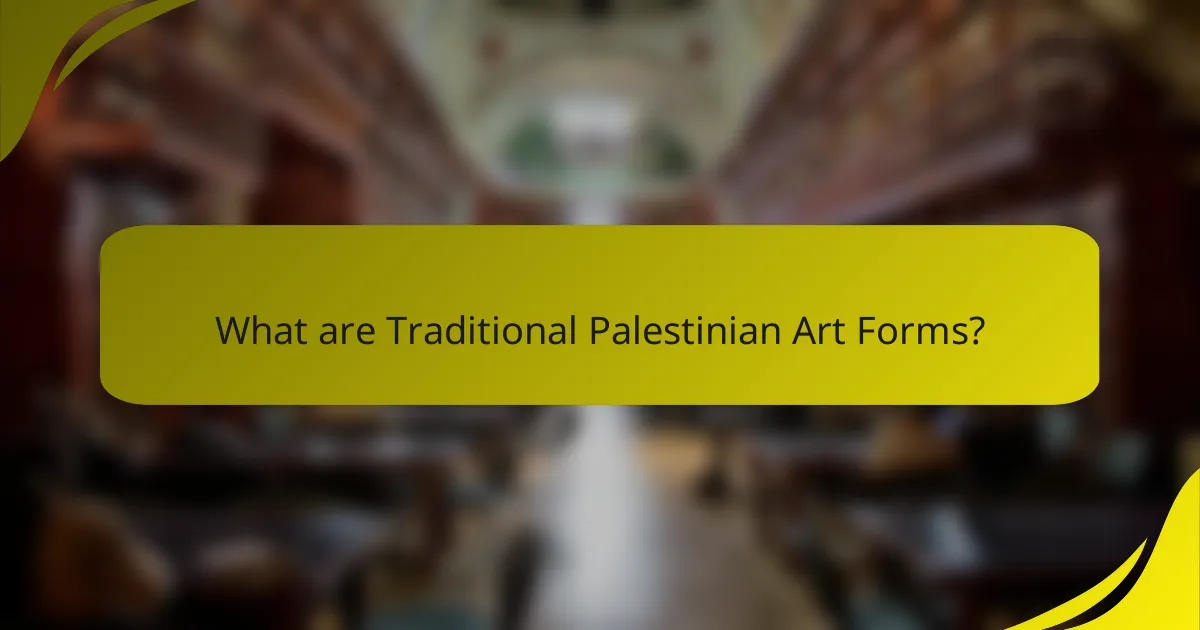
What are Traditional Palestinian Art Forms?
Traditional Palestinian art forms include embroidery, pottery, and calligraphy. These art forms reflect the cultural heritage and identity of the Palestinian people. Embroidery, especially the traditional “tatreez,” features intricate patterns and designs. Pottery often showcases unique shapes and traditional motifs. Calligraphy is used to express religious texts and poetry artistically. Each form serves as a medium for storytelling and cultural expression. Historical contexts show that these art forms have been passed down through generations. They are vital in preserving Palestinian traditions and identity.
How do Traditional Palestinian Art Forms reflect cultural identity?
Traditional Palestinian art forms reflect cultural identity through their themes, techniques, and materials. These art forms often depict historical narratives, daily life, and social values. For example, traditional embroidery, known as tatreez, showcases regional patterns and colors that signify different Palestinian communities. The use of specific motifs in pottery and weaving also connects to Palestinian heritage and storytelling. Furthermore, these art forms serve as a means of resistance and preservation of identity in the face of political challenges. Historical contexts, such as the Nakba, have influenced the evolution of these artistic expressions. Overall, traditional Palestinian art encapsulates the collective memory and resilience of the Palestinian people.
What historical influences shape these art forms?
Traditional Palestinian art forms are shaped by various historical influences. These influences include the region’s diverse cultural heritage, which encompasses Arab, Ottoman, and Byzantine elements. The impact of historical events, such as the 1948 Nakba, significantly affected artistic expressions and themes. Additionally, the interplay of socio-political contexts has led to the evolution of art as a medium for resistance and identity. The use of specific materials, like olive wood and natural dyes, reflects local resources and traditions. Furthermore, traditional techniques have been passed down through generations, preserving the cultural narrative. Overall, these historical influences intertwine to create a rich tapestry of Palestinian artistic expression.
How do Traditional Palestinian Art Forms differ from other regional art?
Traditional Palestinian art forms are distinct due to their unique cultural and historical influences. They often incorporate traditional motifs, such as olive trees and geometric patterns, reflecting the region’s heritage. In contrast, other regional art may focus on different themes or techniques. Palestinian art frequently utilizes materials like olive wood and natural dyes, emphasizing local resources. Additionally, the narrative aspect of Palestinian art often addresses social and political issues, which may not be as prevalent in other regional art forms. This focus on storytelling through visual means sets Palestinian art apart. Historical contexts, such as the impact of displacement, further shape these artistic expressions. Overall, the combination of specific themes, materials, and historical influences creates a distinct identity for traditional Palestinian art.
What techniques are commonly used in Traditional Palestinian Art?
Traditional Palestinian art employs various techniques, including embroidery, ceramics, and wood carving. Embroidery, known as “tatreez,” features intricate patterns and motifs that reflect cultural heritage. Ceramics often showcase traditional designs and are used in functional and decorative pieces. Wood carving involves detailed craftsmanship, often seen in furniture and decorative items. These techniques are rooted in historical practices and reflect the identity and experiences of the Palestinian people. Each technique carries unique symbolism and has been passed down through generations, preserving cultural narratives.
How is embroidery utilized in Palestinian art?
Embroidery is a significant element in Palestinian art. It serves as a means of cultural expression and identity. Traditional Palestinian embroidery, known as “tatreez,” incorporates intricate patterns and vibrant colors. Each design often represents specific regions or communities within Palestine. The embroidery is typically used on garments, home textiles, and decorative items. It reflects social and historical narratives, often telling stories of heritage and resistance. The practice has been passed down through generations, maintaining its relevance in contemporary art. Today, many artists incorporate embroidery into modern designs, blending tradition with innovation. This adaptation helps preserve Palestinian cultural heritage while appealing to a broader audience.
What role does pottery play in Traditional Palestinian Art?
Pottery serves as a significant element in Traditional Palestinian Art. It reflects the cultural identity and heritage of Palestinian communities. Pottery techniques have been passed down through generations. These techniques often incorporate local materials and traditional designs. The decorative patterns on pottery often symbolize cultural narratives and historical events. Pottery also plays a practical role in daily life, used for cooking and storage. The craftsmanship involved in pottery-making showcases artistic skills and creativity. Overall, pottery embodies both functional and aesthetic values within Palestinian culture.
How do woodwork and carving techniques manifest in this art form?
Woodwork and carving techniques manifest in traditional Palestinian art forms through intricate designs and craftsmanship. Artisans utilize local wood types like olive and cedar for their durability and aesthetic appeal. The carving process often features geometric patterns and motifs inspired by cultural heritage. These techniques reflect centuries of tradition, passed down through generations. The precision in carving showcases the artisan’s skill and attention to detail. Decorative elements often include floral designs and calligraphy, emphasizing cultural significance. Historical records indicate that woodwork has been a vital aspect of Palestinian craftsmanship for centuries. This art form not only serves functional purposes but also acts as a medium for cultural expression.
What materials are essential in Traditional Palestinian Art Forms?
Essential materials in Traditional Palestinian Art Forms include olive wood, glass, and textiles. Olive wood is commonly used for carving intricate designs. Its durability and local availability make it a preferred choice. Glass is often utilized in traditional mosaics and decorative items. The vibrant colors and craftsmanship highlight Palestinian artistry. Textiles, particularly embroidered fabrics, are significant in traditional clothing and crafts. They showcase cultural symbols and heritage through intricate patterns. These materials reflect the rich history and cultural identity of Palestine.
What natural materials are commonly used in these art forms?
Natural materials commonly used in traditional Palestinian art forms include olive wood, clay, and natural dyes. Olive wood is favored for its durability and unique grain, often crafted into intricate sculptures and functional items. Clay is utilized for pottery, reflecting local traditions and designs. Natural dyes, derived from plants and minerals, are employed in textile arts, providing vibrant colors. These materials not only reflect the cultural heritage of Palestine but also sustain traditional craftsmanship.
How do contemporary artists adapt traditional materials?
Contemporary artists adapt traditional materials by integrating modern techniques and innovative concepts. They often recontextualize these materials to reflect current societal themes. For instance, artists may use traditional weaving methods while incorporating synthetic fibers. This blend creates a dialogue between past and present. Additionally, artists often experiment with color and form to challenge traditional aesthetics. They may also combine traditional practices with digital technology. This fusion allows for new expressions and broader accessibility. Such adaptations can be seen in various art forms, including textiles and ceramics. This approach not only preserves traditional methods but also revitalizes them for contemporary audiences.
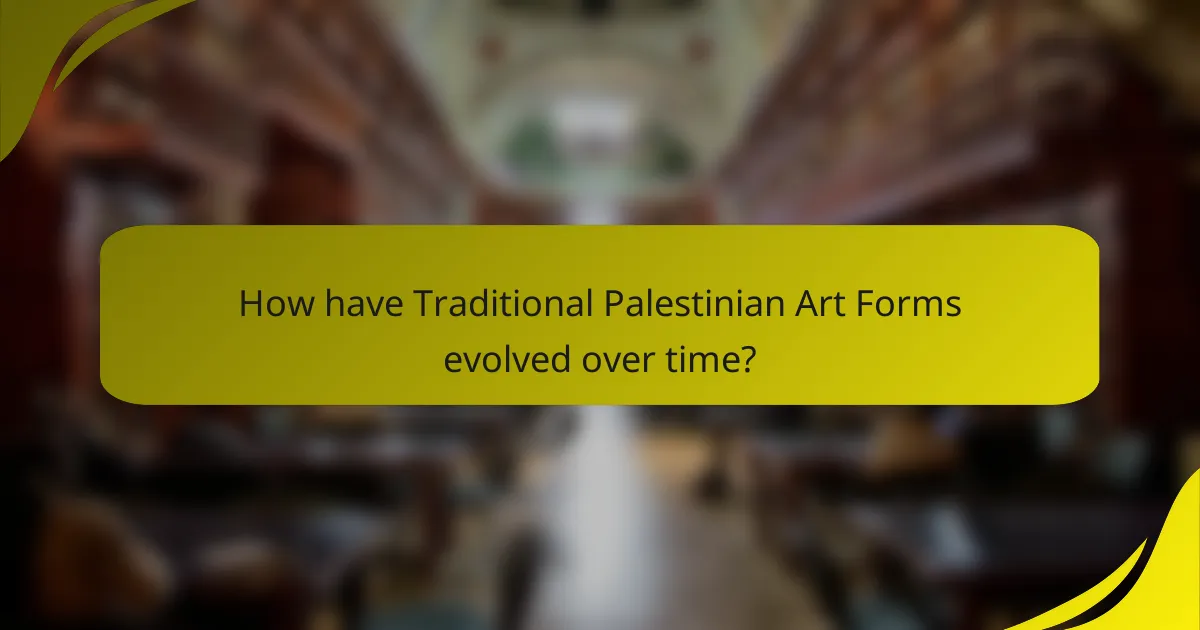
How have Traditional Palestinian Art Forms evolved over time?
Traditional Palestinian art forms have evolved significantly over time due to historical, cultural, and political influences. Initially, these art forms were rooted in ancient traditions, including pottery, embroidery, and woodwork. Over the centuries, external influences, such as Ottoman and British colonialism, introduced new techniques and materials.
In the 20th century, the Palestinian identity became a central theme in art, reflecting resistance and cultural heritage. Artists began to incorporate contemporary styles while maintaining traditional motifs. The Oslo Accords in the 1990s further impacted artistic expression, leading to a resurgence in folk art and crafts.
Today, traditional Palestinian art forms are often blended with modern artistic practices. This evolution showcases a dynamic interplay between preserving heritage and embracing innovation. The ongoing dialogue between past and present continues to shape Palestinian art in the global context.
What contemporary adaptations can be seen in Palestinian art?
Contemporary adaptations in Palestinian art include the use of mixed media and digital technology. Artists often blend traditional techniques with modern materials. This fusion creates a dialogue between past and present. Street art has emerged as a significant form of expression. It addresses social and political issues relevant to Palestinian identity. Performance art is also gaining traction, allowing for dynamic storytelling. Additionally, artists are exploring global themes while maintaining local narratives. Exhibitions now often incorporate interactive elements to engage audiences. These adaptations reflect a vibrant and evolving artistic landscape.
How do modern artists reinterpret traditional techniques?
Modern artists reinterpret traditional techniques by integrating contemporary themes and materials. They often blend historical methods with modern technology. This fusion creates unique expressions that resonate with today’s audience. For example, Palestinian artists may use traditional embroidery techniques while incorporating digital mediums. This approach preserves cultural heritage while making it relevant. Artists also experiment with scale and form, transforming traditional motifs into large installations. Such reinterpretations challenge perceptions of authenticity and cultural identity. Overall, modern adaptations breathe new life into traditional practices, fostering dialogue between past and present.
What influences have contemporary Palestinian artists embraced?
Contemporary Palestinian artists have embraced various influences, including cultural, political, and historical themes. They often draw inspiration from traditional Palestinian art forms, such as embroidery and ceramics. Many artists incorporate contemporary global art movements, blending them with local narratives. Political struggles and identity are central to their work, reflecting the socio-political landscape of Palestine. Artists frequently use their art to comment on issues of displacement and resistance. Collaborations with international artists also shape their perspectives and techniques. The use of mixed media is prevalent, showcasing innovation in material and expression. Overall, these influences create a rich tapestry of artistic expression that resonates with both local and global audiences.
What challenges do Traditional Palestinian Art Forms face today?
Traditional Palestinian art forms face several significant challenges today. One major challenge is the impact of political instability on cultural expression. Ongoing conflict limits artists’ ability to create and showcase their work. Economic constraints also hinder access to materials and resources needed for traditional art forms. Additionally, globalization poses a threat by overshadowing local art with dominant international trends. There is also a lack of institutional support and funding for traditional artists. Furthermore, the preservation of traditional techniques is at risk as younger generations may prefer modern forms of expression. These challenges collectively threaten the survival and evolution of Palestinian artistic heritage.
How do political and social factors impact these art forms?
Political and social factors significantly impact traditional Palestinian art forms. These influences shape the themes and techniques used by artists. For instance, the ongoing conflict has led to a focus on resistance and identity in artworks. Artists often use their craft to express socio-political messages. This is evident in the prevalence of motifs symbolizing heritage and struggle. Social movements can also inspire new artistic expressions and collaborations. The global diaspora of Palestinians affects the preservation and evolution of these art forms. Cultural events and exhibitions often highlight these political narratives, reinforcing their importance.
What efforts are being made to preserve Traditional Palestinian Art?
Efforts to preserve Traditional Palestinian Art include community workshops and cultural festivals. These initiatives aim to educate younger generations about traditional techniques. Organizations, such as the Palestinian Heritage Center, actively document and promote traditional art forms. They provide resources and training for artisans. Academic institutions also contribute through research and exhibitions. Collaborations with international art organizations enhance visibility and support. Additionally, social media platforms are used to share traditional art globally. These combined efforts ensure that traditional practices are sustained and celebrated.
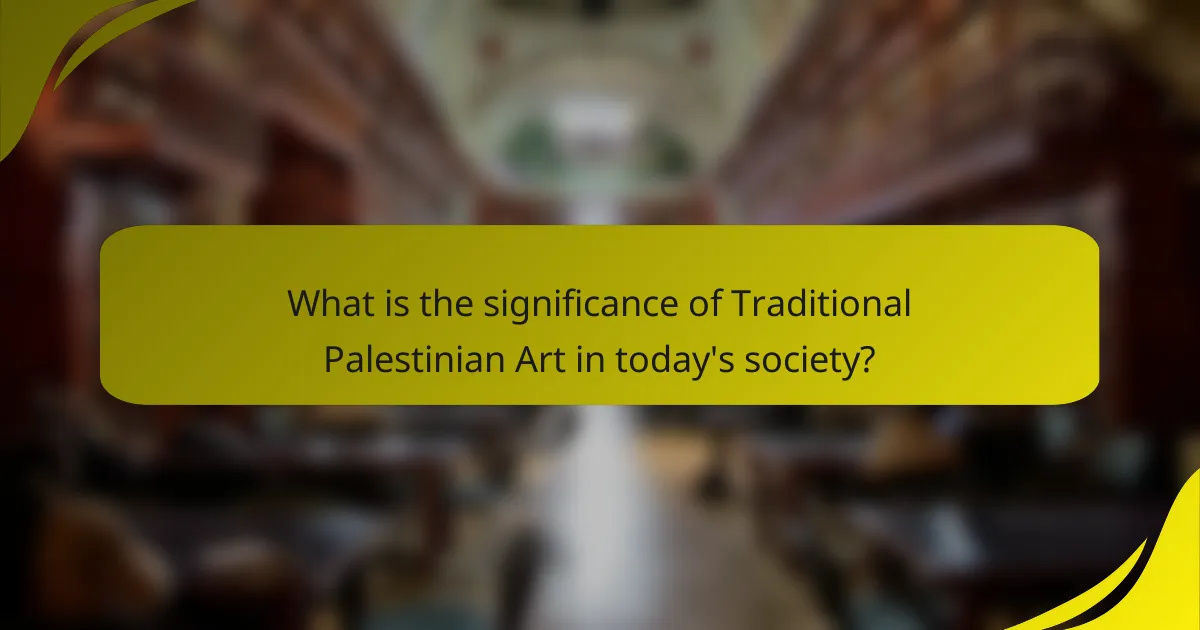
What is the significance of Traditional Palestinian Art in today’s society?
Traditional Palestinian art serves as a vital expression of cultural identity and heritage in today’s society. It reflects the historical experiences and narratives of the Palestinian people. This art form promotes awareness of Palestinian culture globally. Traditional techniques, such as embroidery and pottery, are passed down through generations. They embody the values and stories of the community. Furthermore, contemporary adaptations of these traditions engage younger artists. This revitalization fosters a connection between past and present. Traditional Palestinian art also plays a role in advocacy and resistance. It highlights social and political issues faced by Palestinians today. Through exhibitions and performances, this art form reaches diverse audiences worldwide.
How do Traditional Palestinian Art Forms contribute to cultural heritage?
Traditional Palestinian art forms significantly contribute to cultural heritage by preserving and expressing the identity and history of the Palestinian people. These art forms include embroidery, pottery, and music, each reflecting unique cultural narratives. For example, traditional embroidery, known as “tatreez,” often features specific patterns that signify regional identities and social status. Pottery techniques, passed down through generations, showcase historical craftsmanship and local resources. Furthermore, music and dance traditions, such as “dabka,” serve as communal expressions of resistance and resilience. These artistic practices are integral in maintaining cultural continuity and fostering community solidarity. Through exhibitions and educational programs, traditional Palestinian art is shared globally, enhancing awareness and appreciation of Palestinian culture.
What role do art exhibitions play in promoting Palestinian culture?
Art exhibitions play a crucial role in promoting Palestinian culture by showcasing its rich artistic heritage. They provide a platform for Palestinian artists to express their identity and experiences. These exhibitions often feature traditional art forms, such as embroidery and pottery, alongside contemporary works. This blend highlights the evolution and resilience of Palestinian culture. Moreover, art exhibitions foster dialogue and understanding among diverse audiences. They can challenge stereotypes and misconceptions about Palestine. Events like the Al-Quds Art Festival exemplify this impact by attracting international attention. Such initiatives help preserve and celebrate Palestinian culture on a global scale.
How can education foster appreciation for these art forms?
Education can foster appreciation for traditional Palestinian art forms by integrating them into curricula. Incorporating lessons on techniques and materials used in these art forms enhances understanding. Engaging students in hands-on workshops allows for experiential learning. Exposure to historical context deepens appreciation for the cultural significance. Collaboration with local artists provides authentic insights and mentorship. Field trips to galleries or cultural centers showcase these art forms in practice. Research studies show that arts education increases cultural awareness and sensitivity. For example, the National Endowment for the Arts found that arts education promotes empathy and community engagement.
What are some practical ways to engage with Traditional Palestinian Art?
Participating in workshops is a practical way to engage with Traditional Palestinian Art. These workshops often teach techniques such as embroidery and pottery. Visiting art galleries showcasing Palestinian artists also provides direct interaction with the art. Attending cultural festivals featuring traditional art can deepen understanding and appreciation. Supporting local artisans by purchasing their work helps sustain these art forms. Engaging in online platforms dedicated to Palestinian art allows for broader discussions and exposure. Collaborating with artists on community projects fosters creativity and cultural exchange. Lastly, studying the history and significance of the art enhances overall engagement and respect for the tradition.
How can individuals support Palestinian artists and their work?
Individuals can support Palestinian artists and their work by purchasing their art directly. Buying artwork from Palestinian artists provides them with financial support. Additionally, sharing their work on social media increases visibility. Promoting exhibitions and events featuring Palestinian artists helps them reach a wider audience. Supporting organizations that advocate for Palestinian art can also be beneficial. Engaging in conversations about their work raises awareness of their cultural significance. Finally, donating to art initiatives that focus on Palestinian artists can provide essential resources.
What resources are available for learning about Traditional Palestinian Art?
Books on Traditional Palestinian Art include “Palestinian Art: From 1850 to the Present” by A. A. B. Al-Azzawi. This book provides a comprehensive overview of the subject. Online platforms like the Palestinian Museum’s website offer virtual exhibitions and educational resources. The museum focuses on preserving and promoting Palestinian heritage. Documentaries such as “The Art of Resistance” highlight contemporary Palestinian artists and their work. Workshops and courses are available through organizations like the Khalil Sakakini Cultural Center. These programs teach traditional techniques and materials. Academic journals often publish articles on Palestinian art, providing scholarly insights and research findings.
Traditional Palestinian art forms encompass various techniques, materials, and contemporary adaptations, highlighting the cultural heritage and identity of the Palestinian people. Key art forms include embroidery, pottery, and calligraphy, each reflecting historical narratives and social values. The article explores how these art forms have evolved over time, influenced by historical contexts and socio-political factors, while also addressing the challenges faced in preserving traditional practices. Additionally, it examines the role of contemporary artists in reinterpreting traditional techniques and materials, fostering a dialogue between heritage and modernity.
